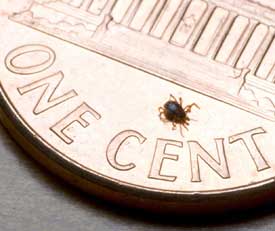
BABESIOSIS

Image: Ixodes scapularis nymph on the face of a penny. Ticks in this stage are usually the size of a poppy seed and can transmit Babesia microti if infected. Photo credit: Graham Hickling, University of Tennessee, Caption credit: CDC
What is Babesiosis?
Babesiosis is a rare, parasitic infectious disease mainly transmitted by the bite of an infected deer tick. Primarily a disease in animals, babesiosis in rare cases can infect humans via a tick bite, transmission during a transfusion of blood products, or from an infected mother to her baby during pregnancy or delivery. According to the Centers for Disease Control and Prevention (CDC), more than 50 transfusion-related cases have occurred in the United States. Babesiosis is an infection that attacks the red blood cells in humans. After a tick bite, the incubation period is 1-4 weeks and is followed by a gradual onset of symptoms. A disease occurring mainly in the Northeastern and upper Midwest of the United States, Babesiosis has also been found on the West Coast as well. This tick-borne disease usually peaks during the warm months from July through September but can appear anytime throughout the year if it is a transfusion-associated transmission or from mother to child.
What are the symptoms?
Many people who are infected with Babesiosis do not have any symptoms. Others have flu-like symptoms such as fever, chills, headache, nausea, vomiting, loss of appetite, fatigue, and muscle aches. According to the CDC, because these parasites infect and destroy the red blood cells, it can cause a type of anemia known as hemolytic anemia. This can lead to jaundice and dark colored urine. Symptoms can be mild to severe (life-threatening if untreated) especially if the people have underlying illnesses, are elderly, do not have a spleen, or have impaired immune systems (HIV, malignancy, steroid therapy). A skin rash is not a feature of this infection.
How is Babesiosis diagnosed?

Image: A nymphal stage Ixodes scapularis tick (approximately the size of a poppy seed) is shown here on the back of a penny. Credit: G. Hickling, University of Tennessee. Caption credit: CDC
Diagnosis is made according to symptoms and by examining blood samples. Blood tests may reveal:
- a decreased platelet count
- hemolytic anemia
- protein in the urine
- elevated liver enzymes
- elevated blood urea nitrogen (BUN) levels
- elevated Creatinine levels
Blood smears are also done to confirm the presences of the parasites within the red blood cells under a microscope.
Is treatment available?
Those people who do not have symptoms do not require treatment according to the CDC. Treatment is individualized. For those who become ill, treatment with combination medications is the course of therapy for 7-10 days. Typically, an antibiotic along with a medication that destroys the parasite are prescribed for adults. Depending on severity of infection, supportive care may be rendered such as antipyretics (fight fevers), blood transfusions, mechanical ventilation to assist breathing, or dialysis.
What can be done to prevent Babesiosis?
Avoid areas where ticks are normally found such as high grasses, weeds, and wooded areas and if outdoor activities are performed in these areas, wear tick repellent. Examine skin daily for any ticks on the body and remove them completely. Try and shower as soon as indoors. Prevention of transfusion transmitted Babesiosis depends on intervening before potential blood donors donate according to the Center for Disease Control and Prevention, for screening purposes.
The above information is not intended to replace the advice of a health care provider. Consult your provider in the event of any questions or concerns.
Additional information on Babesiosis can be obtained from:


